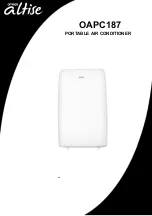
# 504,910M
Page 13
OPERATION
Outdoor unit and indoor blower cycle on demand from the
room thermostat. When the thermostat blower switch is
moved to the ON position, the indoor blower operates
continuously.
Compressor Time Delay (TD1)
A compressor time delay is used to prevent compressor
short cycling and to prevent the compressor from running
backwards. When there is demand for a cooling cycle, the
control delays compressor operation for about 5 minutes
(+ or – 2 minutes). Do not bypass the control.
High Pressure Switch
SCU12M units are equipped with a high pressure switch
that is located in the liquid line of the compressor. The
switch (SPST, manual reset, normally closed) removes
power from the compressor when discharge pressure
rises above factory setting at 640 ± 10 psi.
Filter Drier
A drier is shipped with each SCU12M unit. The drier must
be field installed in the liquid line between the liquid line
service valve and the expansion valve.
This drier must
be installed to ensure a clean, moisture-free system.
A
replacement drier is available through the local distributor.
Failure to install the filter drier will void the warranty.
Maintenance and service must be performed by a quali-
fied installer or service agency.
At the beginning of each cooling season, the system
should be checked as follows:
1. Clean and inspect condenser coil. Coil may be
flushed with a water hose. Be sure the power is off
before using water to clean the coil.
2. Outdoor fan motor is pre-lubricated and sealed. No
further lubrication is needed.
3. Visually inspect connecting lines and coils for evi-
dence of oil leaks.
4. Check wiring for loose connections.
5. Check for correct voltage at unit (with unit operating).
6. Check amp-draw outdoor fan motor.
Unit nameplate _________ Actual _________
NOTE – If owner complains of insufficient cooling, the
unit should be gauged and refrigerant charge
checked. Refer to the
Charging
section on page 10.
Indoor Coil
1. Clean coil, if necessary.
2. Check connecting lines and coils for evidence of oil
leaks.
3. Check condensate line and clean, if necessary.
Indoor Unit
1. Clean or change filters.
2. Adjust blower speed for cooling. Measure the pres-
sure drop over the coil to determine the correct blower
CFM. Refer to the unit information service manual for
pressure drop tables and procedure.
3. Belt drive blowers: Check belt for wear and proper
tension.
MAINTENANCE
Before performing maintenance operations on
system, turn the electric power to unit OFF at
disconnect switch(es). Unit may have multiple
power supplies. Electrical shock could cause
personal injury or death.
WARNING


































